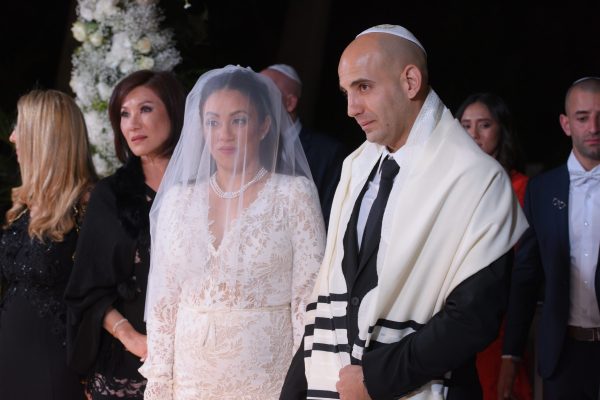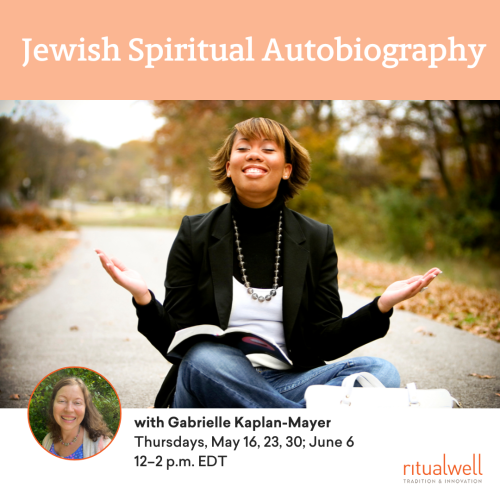The following kavannot (orientations) are an alternative to simply translating the Sheva BrakhotSeven blessings with which the bride and groom are blessed at their wedding. Also refers to the seven days of celebration following the wedding, during which the seven blessings are recited at every meal at which there is a minyan of ten Jews and there is at least one guest who was not present at the wedding. (Seven Wedding Benedictions) as they are being chanted under the wedding canopy. They are quotes—offered without comment—from the Bible or from classic rabbinic texts.
Use of kavannot has the following advantages over straight translation:
- Ancient sacred texts add their inherent and timeless spiritual power to the wedding moment.
- For those present who do not understand Hebrew, these quotes offer a cultural context.
- For those people who know Hebrew, the quotes provide a poetic juxtaposition that deepens the meaning of the blessings.
- It shows respect for the power of Hebrew as a language of prayer. (Straight translation implies that the prayer just stated was not sufficient—a benediction offered in vain.)
We compiled and edited the following kavannot for our wedding, which Rabbi Jane Litman led on Rosh HodeshThe new moon, which marks the beginning of the Jewish month. According to tradition, because women did not participate in the sin of the golden calf, they were given the holiday of Rosh Chodesh. It is customary for women not to work on Rosh Chodesh. Elul 5752. We found them to be potent.
Here is how we used them: To allow as much participation as possible, we used eight participants—one to chant the entire set in Hebrew while holding the goblet, and seven readers of the kavannot who each stood up in place when the turn came to read aloud. The English reading preceded the Hebrew chanting of each benediction. The “back-and-forth” in location between the assembled onlookers and the person chanting under the canopy helped join together the entire group and added to the magic of the moment.
I
The prophet Joel proclaimed:
Fear not, O soil, rejoice and be glad;
For THE MARVELOUS ONE has wrought great deeds!…
The trees have borne their fruit;
Fig tree and vine have yielded their strength.
O children of Zion, be glad, Rejoice in your BOUNTIFUL God!
(Joel 2:21–23)1
II
The psalmist declared:
How many are the things you have made, O SOURCE OF LIFE!
You have made them all with wisdom;
the earth is full of Your creations.
(Psalm 104: 24)2
III
In the 1800-year-old MishnahThe first layer of Jewish oral law, written down in Palestine around 200 CE. The Mishna consists of six books or sedarim (orders), each of which contains seven to twelve tractates or masechtot (singular masechet). The books are Zeraim (Seeds), Moed (Festival), Nashim (Women), Nezikin (Damages), Kodashim (Holy Things), and Tehorot (Purities)., we are told that …
Rabbi Akiva would say:
“Precious is the human being, who was created in the divine image.
It was an act of still greater love
that it was made known to us
that we were created in the divine image –
the Bible says, in the image of God were humans made.”
(Mishnah Avot 3:14)3
IV
The Mishnah also teaches that…
Humankind was portrayed as having been created from a single ancestor,
to portray the grandeur of the Blessed Holy One.
For a person mints coins with a single stamp,
and they are all alike one another.
But the One who rules above all others – the Blessed Holy One –
minted all human beings with the same stamp
with which the first person was made,
yet not one of us is like anyone else.
Therefore we are each obliged to maintain,
“On my account the world was created.”
(Mishnah Sanhedrin 4: 5)4
V
So spoke the prophet Amos:
A time is coming – declares THE FAITHFUL ONE…
When the mountains shall drip wine and the hills shall wave with grain.
I will restore My people IsraelLit. ''the one who struggles with God.'' Israel means many things. It is first used with reference to Jacob, whose name is changed to Israel (Genesis 32:29), the one who struggles with God. Jacob's children, the Jewish people, become B'nai Israel, the children of Israel. The name also refers to the land of Israel and the State of Israel..
They shall rebuild cities and inhabit them;
they shall plant vineyards and drink their wine;
They shall till gardens and eat their fruits.
And I will plant them on their soil,
Nevermore to be uprooted
From the soil I have given them –
said THE MAKER OF PEACE your God.
(Amos 9:13–15) 5
VI
From MidrashA rabbinic method of interpreting text, often through the telling of stories. Genesis Rabbah:
Once a Roman asked Rabbi Yose bar Halafta,
“How long did it take the Blessed Holy One to create the world?”
The rabbi said, “Six days.”
Said the Roman: “From then until now has been a long time;
what has God been doing ever since?”
The rabbi replied,
“The Blessed Holy One is occupied with matching up individuals into couples…
A suitable match may seem easy to make,
yet God considers it as difficult a task as dividing the Reed Sea.”
(Midrash Genesis Rabbah 68.4)6
VII
From the TalmudThe rabbinic compendium of lore and legend composed between 200 and 500 CE. Study of the Talmud is the focus of rabbinic scholarship. The Talmud has two versions, the main Babylonian version (Bavli) and the smaller Jerusalem version (Yerushalmi). It is written in Rabbinic Hebrew and Aramaic. of Babylonia:
Rav Samuel, the son of Rav IsaacAbraham and Sarah's much-longed-for son and the second Jewish patriarch. Isaac is nearly sacrificed by his father at God's command (Genesis 22). He is married to Rebecca and is the father of Esau and Jacob. His Hebrew name is Yitzchak.,
would dance at weddings
while juggling three myrtle branches.
Rabbi Zera said, “The Elder Rabbi is embarrassing us.”
But when this Rav Samuel died,
a fire from heaven came down in the form of a myrtle branch
and set his coffin apart from the people.
(It is said that such a sign appears only once or twice in a generation.)
Rabbi Zera remarked,
“It appears that the Elder Rabbi’s foolishness has been well received.”
(Talmud of Babylonia, Ketubot 17a; cf. Midrash Genesis Rabbah 59.4)7
————————-
Copyright 1992 by David E. S. Stein. Used by permission of the author.













